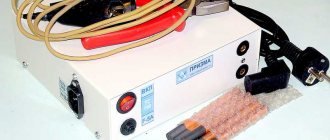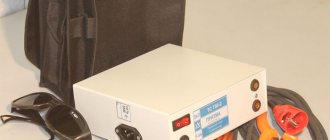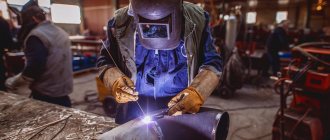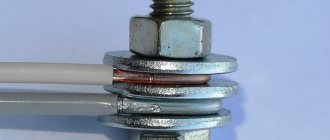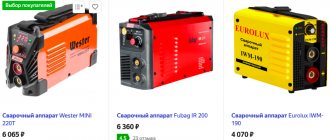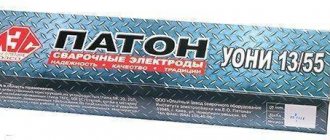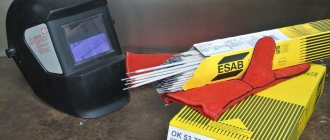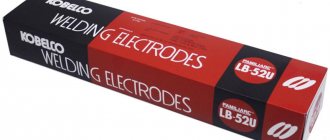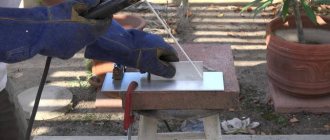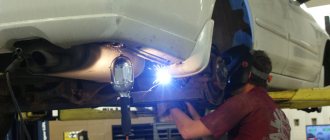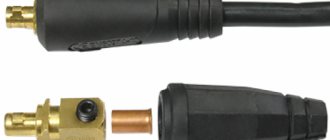Welded connection of wires is preferable to other methods, because the result of this process is reliable, high-quality contact, ensuring trouble-free operation of electrical wiring for a long time. Welding copper wires is most common, since household wiring involves the use of electrical wires made of copper. Welding of copper wiring is carried out using alternating or direct current (voltage 13-36 V); it is possible to adjust the current with the welding machine.
Inverter welding machine
The inverter device has clear advantages over other devices:
- Small-sized parameters;
- Light weight;
- Adjustment of current parameters;
- The presence of a portable belt (it is convenient to carry out work on a stepladder, in a junction box);
- A stable arc that ignites at low currents;
- Quality of welded joints;
- Less energy consumption without changing the voltage of the household electrical network.
In addition, welding is carried out using transformer devices, devices, stations, devices made independently (if you have certain skills).
The ease of operation of the do-it-yourself electric arc spot welding machine has made it the most widespread. Main parameters of this equipment:
- Electric arc current;
- The mains voltage that forms an arc;
- Type of electric current (alternating, direct).
Inverter type devices
Advantages of welding inverters
The advantages of inverter units are well known to specialists. Certain models are equipped with a strap that allows you to carry the inverter on your shoulder. This makes it possible to carry out welding work with twisting in a junction box while standing on a stepladder. The inverter can be connected to household electrical wiring, since the device has low power consumption.
Inverters have a wide range of electric current regulation. Their arc is very stable and ignites perfectly at low welding currents. For this reason, even an untrained electric gas welder can quickly achieve an amazing effect and achieve optimal quality of wire welding.
Household welding devices are marked with the abbreviation MMA. Then numbers are indicated indicating the operating current - 200 or 250 V. The professional device operates in a temperature range of up to 150 degrees. The home device has a spectrum from 0 to +30. Another difference between a home device and a professional and industrial device is the duration of the operating cycle.
Algorithm of operation of the welding inverter
A professional type inverter will operate for 8 hours with short breaks, an industrial type - 24 hours with a break of 30 minutes. The device, intended for household use, operates without interruption for 30 minutes, and then cools down for an hour.
When welding a copper type cable, a special copper-plated carbon electrode is used, which is popularly called a “pencil”. If you don't have a carbon electrode, you can take a standard carbon rod from an unusable battery. Welding current, depending on the cross-section and number of wires, is used at different voltages. A suitable mode is one in which the electrode does not stick to the welding area and the arc is stable.
Welding technology
Welding work must be carried out using a protective mask, glasses, gloves, and special clothing. There is a possibility of getting burned by hot metal and “catching bunnies.”
Welding of copper wires at home with an inverter is carried out using graphite and carbon electrodes. You can replace the electrodes with the carbon rod of a used battery.
Approximate welding current range:
- 2 cores, cross section of each 1.5 mm² - 70 A;
- 3 cores, cross section of each 1.5 mm² – 80-90 A;
- 2-3 cores, cross-section 2.5 mm² – 80-100 A;
- 3-4 cores, cross-section 2.5 mm² – 100-120 A.
The copper used in the manufacture of electrical wires is of different composition and quality, which determines the welding mode used. Indicators of the optimally selected mode: the electrode does not stick to the welded area, the arc is stable. This combination can be maintained if you have experience in welding.
Welding process:
- The insulating sheath of the copper cable is removed (7-10 cm);
- Stranded wires are twisted;
- The twisted copper wires are trimmed to form an even cut. The remaining twist length is 5 cm;
- A copper clamping mechanism for removing excess heat is placed on the twist, and grounding (“ground”) is connected;
- The twist section is brought to the electrode;
- Welding work is carried out until a molten copper ball appears at the end of the wires, 1-2 seconds is enough;
- After welding of the copper strands stops so that the insulating material remains intact;
- The cooled ends of the wiring must be insulated (insulating tape, heat-shrink tubing).
In addition, it is necessary to promptly change the copper welding tip, which holds the electrode during welding. The main function is to supply electric current to the electrode rod. Its condition determines the quality of the weld: the hole inside the tip should tightly hold the rod, but it quickly loses its properties during the welding process. The copper welding tip wears out and most often requires replacement.
How to cook with carbon electrodes
Carbon arc welding was invented by Russian engineer Nikolai Benardos back in 1882. In fact, this is the oldest method of electric welding. Today, carbon or graphite electrodes are used much less frequently than metal electrodes, but they still have their own scope of application.
Properties and varieties
A carbon electrode is a solid rod consisting of coal (coke) and several additives. Resin is used here as a binding element.
These rods can be used to weld all types and varieties of metals - from refractory and heavy to light and porous. The diameter of the carbon electrode can vary from 1.5 to 25 mm, and the length - from 25 to 300 mm (the longest are used when the parts to be connected are located in a hard-to-reach place). They can also have different shapes:
- round;
- semicircular;
- rectangular;
- hollow.
In most situations, round and semicircular electrodes are used for work - this is the best option for obtaining a standard weld.
Rectangular products are mainly used to seal defects on steel surfaces, while hollow ones are characterized by the fact that they are capable of creating a U-shaped groove at the joint.
It is also worth knowing that in addition to the usual ones, there are copper-plated carbon electrodes. They are coated with copper to increase strength, but all other performance properties remain approximately the same.
Process Features
Electrodes made from coal differ from metal ones in that they are infusible. This means that during welding they act as a conductor of electricity, but do not become part of the weld pool.
During operation, the carbon rods heat up to very high temperatures. And if you continue heating, then almost immediately they will go from a molten state to a boiling state (by the way, coal boils at a temperature of 4200 ° C).
Due to the characteristics of the material, only direct electric current of straight polarity can be used in the welding process. Accordingly, the minus (cathode) here should be on the electrode, and the plus (anode) on the metal surface of the product.
When working with carbon electrodes, the welder usually requires filler elements. In this case, welding can be done in two ways:
- from left to right (in this case, the additive is behind the electrode);
- from right to left (there is an additive in front).
Interestingly, when welding from left to right, thermal energy is used more efficiently, and this allows you to increase the speed of work. However, in practice you can often find the “right to left” technology - it is more familiar.
In some situations, you can do without an additive, for example, when flanging thin metal products or when welding corner joints . Moreover, if you use a carbon electrode without additives to join metal sheets with a thickness of up to 3 mm, then the productivity will be an order of magnitude greater than when welding with other electrical conductors.
Use in home workshops
To work with carbon electrodes at home, a standard electric arc welding machine is suitable. Since the thermal conductivity of carbon rods is low, an arc can be created with a current of only 3-5 Amperes.
Moreover, this electric arc, if necessary, extends to a length of 30-50 millimeters. The electrode evaporates slowly and does not stick to the metal, so it is quite easy to guide the carbon arc in the direction of the future seam.
The skills needed to perform simple jobs (such as welding wires, welding thin metal plates, etc.) are acquired very quickly in this case.
Home craftsmen should not cook outdoors, but strictly indoors. The carbon arc reacts to wind blows, gas flows, magnetic fields and other influences.
In order not to waste time rearranging the electrode in the holder and so that it does not get too hot during welding, it can be sharpened at both ends in advance. When one end overheats, the electric holder is rotated 180° and welding continues with the other end.
Craftsmen who do not have too many consumables on hand should use this advice.
Some specialists use carbon and graphite electrodes to weld copper busbars at transformer substations. And in home handicraft workshops, such electrodes can, for example, weld copper wires.
Bronze rods would be a good filler material in this situation. The diameters of such rods are selected depending on the thickness of the parts being welded and are calculated using special formulas.
In addition, carbon electrodes can be used to perform not only welding work, but also cutting operations on metal products.
Working with aluminum
Carbon electrodes are used to connect even aluminum products, which are traditionally considered difficult to weld. Aluminum has low density, significant thermal conductivity and resistance to corrosion.
This metal melts at a temperature of 660 °C, and it combines quite well with oxygen, which is why it is covered with a film of aluminum oxide (chemical formula - Al2O3).
The presence of such a film, as well as the ease of formation of cracks and pores in the weld metal, are the main difficulties encountered when welding aluminum. But the use of carbon electrodes makes it possible to cope with them.
In particular, this is the method used to connect aluminum busbars in electrolysis shops. Tires are traditionally butt welded on a graphite or aluminum backing.
Graphite plates with cutouts opposite the seam are mounted on the sides of the tires. These cutouts make it possible to move the end and start points of the seam beyond the boundaries of the working section.
When welding aluminum surfaces using carbon arc welding, the filler material is wire or rod made of the same metal. To ensure that the oxide film does not interfere and does not affect the result, AF-4A flux, which is a homogeneous, fine white powder, is added to the edges of the seam.
Electrodes for welding wires
The choice of the appropriate type of electrode determines the quality of the work done. It is necessary to select welding tools that optimally meet the parameters of the upcoming process. The general classification of these tools used in the welding process includes electrodes for:
- Alloy steel;
- High-alloy steel with non-standard parameters;
- Metal surfacing (applying a metal alloy or metal to the surface of an object by fusion welding);
- Non-ferrous metals;
- Structural steel;
- Cast iron.
The electrode coating defines the following typology:
- A – acid coating (oxide of iron, silicon, manganese);
- B – basic coating that allows welding with direct current of alternating polarity. Contains calcium carbonate, calcium fluoride;
- C – cellulose spraying creates gas protection during welding (flour, compounds of organic origin);
- R – rutile (rutile, organic, mineral components) provides a low percentage of metal splashing and gas protection.
Electrodes for welding wires:
- Coal – electrical coal;
- Graphite – crystalline carbon.
Graphite electrodes for welding
Composition – graphite, a carbon substance of dark gray color with a metallic sheen. The soft material makes it easy to cut elements. Graphite electrodes for welding show better results compared to carbon electrodes.
Peculiarities:
- The graphite electrode remains intact during the welding process;
- The cost is lower than coal;
- Suitable for inverter welding machines equipped with current regulation;
- The connection of wires by welding a graphite rod is durable and reliable;
- Welding with a graphite electrode ensures the metal's resistance to oxidation.
- Low consumption during welding due to the high melting point (four times higher than copper);
- When welding wires with a graphite electrode, it is possible to replace it with improvised graphite products (graphite rod, brushes of commutator motors, battery rods);
- The absence of copper plating of graphite substitutes is solved by using an alligator clip for the electrode instead of standard holders, and an alligator clip is also used to connect the mass.
- Do-it-yourself welding of wires in a junction box with these clamps is more convenient due to their smaller dimensions.
Application and features of work
It is clear that the graphite electrode is used not only for welding wires - its scope of application is much wider. For pre-treatment of metal before welding or other types of processing, cutting metal workpieces, processing metal edges - this type of electrodes is used for all these tasks. The use of graphite allows you to quickly and efficiently cut rivets and pierce elements made of alloy or carbon steel. Special rods are also used for melting steel, cast iron and alloys in electrothermal furnaces. They are made with nipples, which allows them to be connected to each other, which is why the electrode is supplied to the furnace continuously. The use of graphite electrodes for arc cutting of metal reduces the amount of scrap.
Graphite electrodes are also used in the following processes:
- welding of non-ferrous metal products;
- welding of defects obtained during casting;
- welding of thin-sheet metal elements;
- surfacing of carbide parts to the base.
Work with a graphite electrode can also be carried out with filler material. A rod of material used as a filler material can be fed during the welding process or placed in advance at the location of the seam.
It must be remembered that working with this type of electrodes has its own characteristics. During long-term welding, so that the rod material is not consumed too quickly and the arc is stable, a minus must be applied to the electrode (that is, straight polarity must be used). External factors have a significant impact on arc stability. The efficiency when working with graphite is lower compared to consumable electrodes. The joints obtained as a result of welding are not very ductile, and the appearance of voids cannot be ruled out. The work itself, if a carbon or copper-graphite rod is used, differs significantly from welding with conventional electrodes, so only experienced personnel should be allowed to perform critical tasks.
